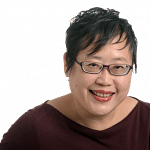-
Discuss The Cunning Of Uncertainty on Aug 31
Austrian sociologist Helga Nowotny, who is a past president of the European Research Council, calls the uncertainty many people feel about living today "cunning" because that uncertainty often has everyone expecting the worst when, as she points out, it is also possible that something good might just happen instead.
Join senior writer Cheong Suk-Wai at The Big Read Meet on Aug 31 to discuss the pros and cons of Nowotny's perspectives in her book, The Cunning Of Uncertainty, from 6.30pm in the Central Public Library, Basement 1, National Library Board headquarters at 100 Victoria Street. Sign up for it at any NLB e-Kiosk or go to www.nlb. gov.sg/golibrary, look for "The Big Read Meet" and follow the steps.
If you cannot be at the Meet, but want to share your views, e-mail your thoughts in no more than 100 words to suk@sph. com.sg. We will publish the best contributions in The Big Read.
Waking to the wonders of the world
The eclectic Annie Dillard has spent a lifetime evoking the joys of being alive

THE ABUNDANCE: NARRATIVE ESSAYS OLD AND NEW By Annie Dillard
Canongate/Hardback/271 pages/ $32.95 with GST from Books Kinokuniya or on loan from the National Library Board under the call number English 814.54 DIL
Like moths to a flame, writers who taste success early tend to fizzle out later in life.
Margaret Mitchell, who wrote Gone With The Wind, and Ralph Ellison, author of Invisible Man, won the United States' National Book Award at ages 36 and 40 respectively. They proved to be one-hit wonders.
In 1975, their compatriot Annie Dillard won the Pulitzer Prize for General Non-fiction for her memoir, Pilgrim At Tinker Creek. Aged 30, she was hardly known in US literary circles till then.
Even those who knew her best could not quite fathom Dillard, now 71, including her loving and long- tolerant parents, who often fretted to their rebellious, precocious tomboy of a daughter: "What are we going to do with you?"
That was chiefly because she, and her work, cannot be pigeonholed easily. She seems enamoured of nature, being one who collects rocks, treks in the North Pole and roams the jungles of Ecuador. But she also hates insects with a vengeance.
Then again, she is equally invested in astronomy and geology, likening the sun emerging from a total eclipse to her silver wedding band and finding out the Earth's crust buckles but does not break off irreparably because silicon in the Earth's water keeps all its parts in place.
And just when you think that you have pinned her down as a hardcore science writer, she turns visceral sociologist, bemoaning the 138,000 Bangladeshis killed in a 1991 tsunami and wrestlers eaten up by alligators.
Fittingly, her publishers have asked the equally hard-to-pigeonhole English author Geoff Dyer to write the foreword to this book. It is a bonus for fans of Dyer, who has his own ineffable brand of incisive, offbeat narratives.
Her new essay collection, The Abundance, will go a long way towards introducing her to Generation Z. Perhaps that was her publisher's goal because eight of the 22 essays come from her 1987 autobiography, An American Childhood.
Dillard's aim, if one could call it that, is to awaken the reader's sense of wonder so that he may drink in the delights of everyday life. "We teach our children one thing only, as we were taught: to wake up," she notes.
More importantly, she points out, people have grown so adept at managing transitions in life, the "plunge and surface, lapse and emerge", that they have learnt to discount the efforts and sacrifices they have had to make in doing so.
Much of life is transition, although people hardly notice that moments "plunge and surface, lapse and emerge". Later on in the book, she muses: "Why does death so catch us by surprise, and why love? We still and always want waking. We should amass, half-dressed in long lines like tribesmen, and shake gourds at one another, to wake up; instead, we watch television and miss the show."
Indeed, the great revolution underway in humanity today is the transition from thinking of everything as cause-and-effect to studying how seemingly random happenings actually relate to one another. The last is what Dillard has been doing for much of her life, spanning 14 books and essay collections.
As a child, she recalls in The Abundance's 17th essay, titled Seeing, her way of waking people up was to plant the coins she saved at the roots of trees or cracks in the sidewalk for people to find.
"If you cultivate a healthy poverty and simplicity, so that finding a penny will literally make your day, then, since the world is in fact planted in pennies, you have with your poverty bought a lifetime of days. It is that simple. What you see is what you get."
Her works have endured because she writes such that a person blind at birth can see all that she describes. What is her secret?
She says in the book: "Write about winter in the summer. Describe Norway as Ibsen did, from a desk in Italy... Mark Twain wrote Huckleberry Finn in Hartford, Connecticut. Recently, scholars learnt that Walt Whitman rarely left his room."
The last is, of course, ironic as Whitman was the laureate of the American outdoors.
The Abundance is, however, by no means a feel-good, navel-gazing book. Dillard is too clear-eyed and curious for that. So your armchair trip with her will include watching trapped deer cutting into their necks in a bid to free themselves; how the "muscled ribbon" that is the weasel fights to the death in an eagle's clutches; and ferocious sharks roiling in a wild sea.
"Cruelty is a mystery, and the waste of pain," she muses in the book's 16th essay, plucked from her Pulitzer Prize-winning Pilgrim At Tinker Creek.
Life itself, she notes, is a constant veering between mind and body. As she says of this ultimate paradox: "The mind wants to live forever, or to learn a very good reason why not. The mind wants the world to return its love, or its awareness; the mind wants to know all the world, and all eternity, even God.
"The mind's sidekick, however, will settle for two eggs over easy. The dear, stupid body is as easily satisfied as a spaniel. And, incredibly, the simple spaniel can lure the brawling mind to its dish."
The Abundance is honest and human, and a balm for uncertain times. Her writing has that rare quality of making things you have never found interesting suddenly beguiling.
Witness her analogy for the impermanence of life: "Moths would singe their wings and fall, and their hot wings, as if melted, would stick to the first thing they touched - a pan, a lid, a spoon - so that the snagged moths could flutter only in tiny arcs, unable to break free."
FIVE QUESTIONS THIS BOOK ANSWERS

1 How might you best sustain a healthy curiosity about life?
2 How might you best curb any rebellious tendencies you might have?
3 What distinguishes great writers from serviceable ones?
4 Why should you be fearless rather than fearful?
5 What really matters most in the end?
Just a minute
THE GOOD
1. Annie Dillard is an excellent exponent of the genre known as creative non-fiction. Her compatriot Truman Capote's In Cold Blood is an early example of the genre, with Rick Bragg, Hugh Prather, Kent Nerburn and Anne Lamott developing it into a high art. As a taste of the power of creative non-fiction, here is Dillard on how to become a good writer: "Only after the writer lets literature shape her can she perhaps shape literature. In working-class France, when an apprentice got hurt, or when he got tired, the experienced workers said, 'It is the trade entering the body.' The art must enter the body too.'"
2. The book is an excellent primer on good writing, the sort that moves the heart even as it sharpens the mind. The Abundance should be required reading for any scribe not just for Dillard's varied experience and sensible advice, but also because it is a sheer delight to read.
3. Dillard observes and describes life so acutely that she makes even the most humdrum hovel seem like a hive of curiosities. She casts a keen, kind eye on everything and everyone she encounters.
4. She likes to juxtapose miracles and menace at once. For instance, recalling her trip to the North Pole, she rues walking on floors of ice - and then says it is for witnessing the baptism of a baby, who is sickly and "stiff as a plank". In this cool yet unsettling way, she thrills, surprises and sometimes shocks the reader, daring him to turn the page for another unanticipated revelation.
THE BAD
1. She sometimes succumbs to hyperbole, which rather mars the magic of her prose. For example, she describes the otherworldly pall cast by a total eclipse as "this colour has never been seen on earth". Well, if that were so, why had there been so many other total eclipses before the one she was witnessing, and recording, for posterity?
THE IFFY
1. In exploring all sorts of subjects throughout her life, Dillard has defied a mainstream audience that has always preferred books with entertaining, focused and predictable bents. Might she have enjoyed a wider readership if she had reined in her eclecticism more?
Fact file: Marry brains to improve writing
The American writer Annie Dillard, 71, was born on April 30, 1945, the day Adolf Hilter killed himself.
As a young girl, she read various accounts of World War II. As she recalls in her 1987 autobiography, An American Childhood, that was because she and thousands of her compatriots simply had to read what "came to hand".
"What came to hand in those years were books about the past war: the war in England, France, Belgium, Norway, Italy, Greece; the war in Africa; the war in the Pacific; in Guam, New Guinea, the Philippines; the war, Adolf Hilter, and the camps."
Dillard also has German blood, along with a Scottish, Irish and French ancestry.
The eldest of three daughters of a Pittsburgh-based businessman father and a teacher mother, her maiden name was Meta Ann Doak, which rhymes with "joke" and she recalls her loving parents being great jokers.
On St Patrick's Day, which is commemorated with the colour green, her parents would boil clam shells in green dye and then scatter the shells on the seashore to confound beachcombers.
Dillard, who was quite the tomboy and preferred playing football with the boys, dreamt of running off to join the United States Marines and generally "exploring the neighbourhood".
After she exulted as a tornado hit her town, Dillard's mother said to her: "With your taste for natural disaster, you should try to arrange a marriage with the head of the International Red Cross."
In her second year at university, Dillard wed Robert Richardson instead, an American biographer of Henry Thoreau, Ralph Waldo Emerson and William James, who was 10 years her senior.
She credits him for making her a better writer.
"Marry brains! Marry brains!" she exhorted her students in 1982. She added that marriage forced one to learn faster.
They divorced in the 1970s, just after she won the 1975 Pulitzer Prize for General Non-fiction for her book, Pilgrim At Tinker Creek (1974).
Dillard, who has one daughter, remarried twice after that and taught English for many years at US colleges.
She continues to win awards for her books, notably Teaching A Stone To Talk and The Writing Life.
Join ST's Telegram channel and get the latest breaking news delivered to you.
A version of this article appeared in the print edition of The Sunday Times on August 21, 2016, with the headline Waking to the wonders of the world. Subscribe

